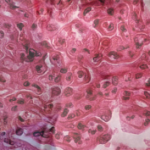 ACR CONVERGENCE 2020—From exploration of new biomarkers to the benefit of repeat biopsy to the promise of new therapeutics, the treatment of lupus nephritis continues to evolve, three experts said at the ACR Convergence session Lupus Nephritis: New Decade, New Approaches.
ACR CONVERGENCE 2020—From exploration of new biomarkers to the benefit of repeat biopsy to the promise of new therapeutics, the treatment of lupus nephritis continues to evolve, three experts said at the ACR Convergence session Lupus Nephritis: New Decade, New Approaches.
Benefit of Repeat Biopsies
Brad Rovin, MD, Lee A. Hebert Professor of Nephrology at The Ohio State University Wexner Medical Center, discussed data pointing to benefits of performing biopsies beyond the initial diagnostic biopsy, so they can be used to help guide treatment.
In the study, 76 patients with lupus nephritis received a maintenance biopsy after the first biopsy, and immunosuppression was continued if histologic activity was present, but discontinued if it was absent.1 If those for whom the therapy was discontinued ended up flaring, induction immunosuppression was restarted.
The process of histologic evaluation and continuation or discontinuation of immunosuppression continued until no patients showed histologic activity.
After the first repeat biopsy, 21 patients showed histologic activity and continued therapy, and 55 had therapy stopped when no activity was found. Six of those patients experienced a flare.
After the second repeat biopsy, six patients continued therapy and 20 had therapy stopped, which was followed by one flare among those patients. No patients undergoing a third repeat biopsy were found to have histologic activity.
The flare rate among those managed using repeat biopsies was 0.012 per patient year, compared with the 0.059 per patient-year that has been seen among those treated with usual care, Dr. Rovin said. This translates into the need to treat 10 patients under the biopsy-managed protocol to prevent one flare. This may sound like a lot of patients, he acknowledged, but it is not out of line with that seen in many therapeutic trials. Repeat biopsy is clearly useful in helping manage patients, but he cautioned the biopsies should be performed at centers with experience in performing them.
“I think it’s a little naive to expect the initial histology will be able to predict patient outcomes or prognosis, because prognosis has to be considered in the context of other variables—access to care, adherence to medications, race, ethnicity and, most importantly, response to therapy,” Dr. Rovin said. “Even if we assume the patient is optimally treated, one snapshot of histology really can’t predict the response to therapy.”
Promise of New Therapeutics
Joan Merrill, MD, director of clinical projects in the Arthritis and Clinical Immunology Program at the Oklahoma Medical Research Foundation, Oklahoma City, discussed recent findings from trials of three drugs: the anti-CD20 obinutuzumab, the calcineurin inhibitor voclosporin and the BLyS-inhibitor belimumab.
When obinutuzumab was added to mycophenolate mofetil, more lupus nephritis patients responded than with mycophenolate mofetil alone. Earlier agents targeting anti-CD20 didn’t meet their primary endpoints for lupus nephritis, but obinutuzumab causes greater B cell depletion.
“However, the rapid steroid taper in this trial might also have helped demonstrate the treatment effect,” Dr. Merrill said.2
In pivotal phase 3 trials, voclosporin demonstrated superior efficacy compared to mycophenolate mofetil alone, and belimumab was effective when added to either mycophenolate mofetil or low-dose cyclophosphamide. Belimumab is one of the safest biologics studied for lupus, she said. In an earlier phase 2 trial of voclosporin, 11.3% of patients in the most effective dosing group died, compared to 1.1% in the placebo group. But this year, the larger and longer phase 3 trial of the drug reported no differences in either deaths or serious adverse events.3
Dr. Merrill pointed to a recent study of lupus patients as an example of using patterns of gene expression in immunologic pathways to help individualize and guide more optimal treatment.4
“We’re learning to simplify this confusing heterogeneity of lupus into some kind of patterns that may become very useful clinically,” she said.
New Biomarkers
Chaim Putterman, MD, associate dean of research at the Azrieli Faculty of Medicine of Bar-Ilan University, Safed, Israel, and professor of medicine and microbiology and immunology the Albert Einstein College of Medicine and Montefiore Medical Center, New York, said better biomarkers are needed to differentiate lupus from other diseases, identify specific organ involvement, measure disease activity and predict who will respond to certain treatments.
Anti-double stranded DNA antibodies and complement components are still the most reliable biomarkers commercially accessible, Dr. Putterman said. Recent research found patients with renal tubular complement C9 staining had significantly higher proteinuria, interstitial fibrosis and chronic disease activity. Patients with glomerular C9 were more likely to be nonresponders to treatment after adjusting for blood pressure, treatment compliance and proteinuria.5,6
The era of big data holds promise for better biomarkers, he said. Several proteins in urine, including angiopoietin-like 4 and L-selectin, have been found to be highly associated with disease activity and useful in tracking pending flares.7
Researchers are now testing itolizumab, which modulates a pathway involving CD6 and activated leukocyte cell adhesion molecule (ALCAM)/CD166, a urine protein identified using proteomics.
The goals of precision medicine using biomarkers, Dr. Putterman said, “are most likely to be realized through big data approaches rather than traditional, hypothesis-driven, single-mediator research.”
Thomas Collins is a freelance medical writer based in Florida.
References
- Malvar A, Alberton V, Lococo B, et al. Kidney biopsy-based management of maintenance immunosuppression is safe and may ameliorate flare rate in lupus nephritis. 2020. Kidney Int. 2020 Jan;97(1):156–162.
- Furie R, Aroca G, Alvarez A, et al. A phase II randomized, double-blind, placebo-controlled study to evaluate the efficacy and safety of obinutuzumab or placebo in combination with mycophenolate mofetil in patients with active class III or IV lupus nephritis. ACR Annual Meeting. Abstract 939. Presented in Atlanta, November 2019.
- Rovin BH, Solomons N, Pendergraft III WF, et al. A randomized , controlled double-blind study comparing the efficacy and safety of dose-ranging voclosporin with placebo in achieving remission in patients with active lupus nephritis. Kidney Int. 2019 Jan;95(1):219–231.
- Guthridge JM, Lu R, Tran LT, et al. Adults with systemic lupus exhibit distinct molecular phenotypes in a cross-sectional study. EClinicalMedicine. 2020 Mar 4;20:100291.
- Wang S, Wu M, Chiriboga L, et al. Renal tubular complement C9 deposition is associated with renal tubular damage and fibrosis in lupus nephritis. ACR Convergence 2020. Abstract 1791. November 2020.
- Moore E, Lally B, et al. The association of urinary membrane attack complex (C5b-9) with proteinuria and glomerular activity in lupus nephritis. ACR Convergence 2020. Abstract 1814. November 2020.
- Vanarsa K, Soomro S, Zhang T, et al. Quantitative planar array screen of 1000 proteins uncovers novel urinary protein biomarkers of lupus nephritis. Ann Rheum Dis. 2020 Oct;79(10):1349-1361.





